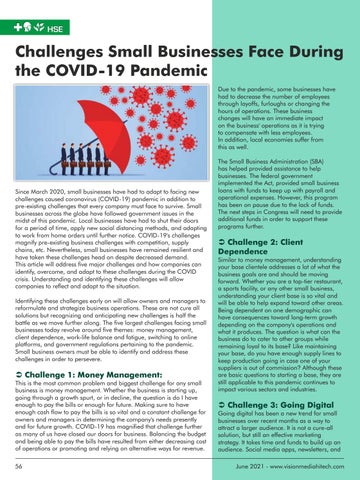Challenges Small Businesses Face During the COVID-19 Pandemic Due to the pandemic, some businesses have had to decrease the number of employees through layoffs, furloughs or changing the hours of operations. These business changes will have an immediate impact on the business' operations as it is trying to compensate with less employees. In addition, local economies suffer from this as well.
Since March 2020, small businesses have had to adapt to facing new challenges caused coronavirus (COVID-19) pandemic in addition to pre-existing challenges that every company must face to survive. Small businesses across the globe have followed government issues in the midst of this pandemic. Local businesses have had to shut their doors for a period of time, apply new social distancing methods, and adapting to work from home orders until further notice. COVID-19's challenges magnify pre-existing business challenges with competition, supply chains, etc. Nevertheless, small businesses have remained resilient and have taken these challenges head on despite decreased demand. This article will address five major challenges and how companies can identify, overcome, and adapt to these challenges during the COVID crisis. Understanding and identifying these challenges will allow companies to reflect and adapt to the situation. Identifying these challenges early on will allow owners and managers to reformulate and strategize business operations. These are not cure all solutions but recognizing and anticipating new challenges is half the battle as we move further along. The five largest challenges facing small businesses today revolve around five themes: money management, client dependence, work-life balance and fatigue, switching to online platforms, and government regulations pertaining to the pandemic. Small business owners must be able to identify and address these challenges in order to persevere.
Challenge 1: Money Management: This is the most common problem and biggest challenge for any small business is money management. Whether the business is starting up, going through a growth spurt, or in decline, the question is do I have enough to pay the bills or enough for future. Making sure to have enough cash flow to pay the bills is so vital and a constant challenge for owners and managers in determining the company's needs presently and for future growth. COVID-19 has magnified that challenge further as many of us have closed our doors for business. Balancing the budget and being able to pay the bills have resulted from either decreasing cost of operations or promoting and relying on alternative ways for revenue. 56
The Small Business Administration (SBA) has helped provided assistance to help businesses. The federal government implemented the Act, provided small business loans with funds to keep up with payroll and operational expenses. However, this program has been on pause due to the lack of funds. The next steps in Congress will need to provide additional funds in order to support these programs further.
Challenge 2: Client Dependence Similar to money management, understanding your base clientele addresses a lot of what the business goals are and should be moving forward. Whether you are a top-tier restaurant, a sports facility, or any other small business, understanding your client base is so vital and will be able to help expand toward other areas. Being dependent on one demographic can have consequences toward long-term growth depending on the company's operations and what it produces. The question is what can the business do to cater to other groups while remaining loyal to its base? Like maintaining your base, do you have enough supply lines to keep production going in case one of your suppliers is out of commission? Although these are basic questions to starting a base, they are still applicable to this pandemic continues to impact various sectors and industries.
Challenge 3: Going Digital Going digital has been a new trend for small businesses over recent months as a way to attract a larger audience. It is not a cure-all solution, but still an effective marketing strategy. It takes time and funds to build up an audience. Social media apps, newsletters, and June 2021 - www.visionmediahitech.com










